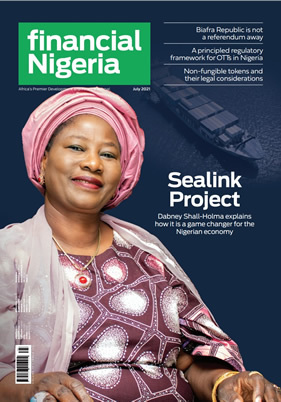
Martins Hile, Editor, Financial Nigeria magazine
Follow Martins Hile
![]() @martinshile
@martinshile
Subjects of Interest
- Governance
- SMEs
- Social Development
Lessons for Nigeria's climate finance strategy 17 Jul 2025
Nigeria's climate finance landscape presents a compelling paradox. Since launching Africa's first sovereign green bond in 2017, the country has raised N58.51 billion ($162 million) through six green bond issuances, positioning itself as a regional leader in sustainable finance innovation. The recently announced plans to issue additional green bonds totalling N300 billion ($200 million) in 2025 further underscore this commitment. However, an estimated sustainable financing gap of over $80 billion annually – per a 2018 report by the United Nations Environment Programme – reveals fundamental limitations in current approaches to climate finance mobilisation.
Nigeria's green bond market, while somewhat successful in establishing market credibility, has predominantly funded large-scale infrastructure projects such as solar installations and afforestation initiatives. But there is limited attention to whether these investments meaningfully enhance the resilience of climate-vulnerable populations or address the underlying drivers of social and economic exclusion that exacerbate climate vulnerability.
78 percent of proceeds from the country's two sovereign issuances (N25.69 billion) and four corporate green bonds (N32.83 billion) have been invested in energy projects. Critical climate adaptation needs in agriculture and water sectors have been given short shrift. This sectoral bias overlooks the reality that Nigeria's 40% food-insecure population and the 33% living in multidimensional poverty face climate impacts most acutely in these neglected sectors. Moreover, the financing structure itself, where pension funds account for 91% of holdings of Nigeria's green bonds, effectively excludes retail investors and civil society organisations from climate finance markets.
The absence of comprehensive impact reporting further undermines accountability. Evidence suggests widespread underreporting and lack of independent verification for most projects funded by these bonds, making it impossible to assess whether climate finance translates into measurable improvements in community resilience or merely produces environmentally beneficial infrastructure with limited social impact.
Kenya's Acorn Holdings green bond demonstrates how climate finance can simultaneously address environmental and social objectives through an integrated design. For instance, the 2019 issuance (KSh4.3 billion/$41 million) used to finance the construction of environmentally friendly student accommodation for about 5,000 university students in Nairobi helped to achieve 40% reduction in utility costs. Of crucial importance is the fact that 22% of the issuance was sold to individual investors via mobile platforms, thereby democratising access to climate finance markets and creating broader ownership of climate solutions.
Kenya's regulatory innovation through the Green Bonds Programme Kenya (GBPK) provides technical support that has reduced approval timelines from 18 to 6 months. This approach – which demonstrates how institutional design can accelerate mobilisation of climate finance – contrasts sharply with Nigeria's fragmented coordination between the Debt Management Office, Ministry of Environment, and National Council on Climate Change. The convoluted institutional framework in Nigeria is what has contributed to the delays in executing planned climate finance initiatives.
Ghana's partnership with the International Finance Corporation established green bond guidelines that mandate impact audits by independent verifiers and reserve part of the proceeds for climate adaptation projects in flood-prone communities. This regulatory framework ensures that climate finance addresses both mitigation and adaptation needs and also incorporates social equity considerations into project selection and implementation.
The contrasts are instructive. On the one hand, Nigeria's green bonds fund large-scale solar installations with limited community engagement. On the other hand, Ghana's framework mandates community oversight committees for projects like flood barriers and solar microgrids, ensuring that climate finance enhances local capabilities rather than simply delivering infrastructure.
Nigerian policymakers must acknowledge that climate vulnerability and development deficits are interconnected challenges requiring integrated solutions. Transformative climate finance should evaluate projects across multiple dimensions, ensuring measurable climate impact, enhanced community resilience, and inclusive economic growth. Investments must prioritise marginalised populations, promote active participation of women and vulnerable groups in governance, and establish sustainable institutional frameworks to foster local ownership and long-term maintenance. This approach would include essential initiatives such as training programmes for solar technicians, climate-smart agricultural extension services, and community-led adaptation planning.
Nigeria’s climate finance governance requires comprehensive restructuring to drive transformative development. Coordination gaps between multiple institutions lead to delays, duplication of efforts, and weakened accountability mechanisms, hindering the effective deployment of climate finance. A unified Climate Finance Authority should consolidate relevant functions from existing institutions. This body will maintain a public registry of verified and bankable green projects, publish quarterly deployment reports as a way of tracking project timelines and beneficiary impacts, and enforce accountability measures, including mandated adaptation spending targets.
Subnational climate finance mechanisms deserve particular attention, given that climate impacts are locally experienced and adaptation solutions need to be contextually appropriate. Lagos State's Climate Adaptation and Resilience Plan (LCARP) represents huge potential for decentralised climate finance that could be more responsive to local development needs. A reformed national climate finance approach would allocate substantial portions of green bond proceeds to state-level initiatives through matching grants, which would require governors to commit matching funds and supported by community oversight committees monitoring implementation.
A better approach for Nigeria's climate finance market entails having sophisticated instruments that address both funding gaps and structural barriers to inclusive development. The current naira-denominated green bond structure limits access to foreign institutional investors concerned about exchange rate volatility, while excluding retail participation prevents broad-based ownership of climate solutions.
Naira-Eurobond hybrid structures could combine naira-denominated retail notes targeting domestic savers and eurobonds collateralised by oil exports, mitigating currency risks and attracting diaspora investors. This approach would broaden the investor base and create pathways for Nigerians abroad to contribute to climate finance mobilisation.
A dedicated Green SME Window should reserve substantial funding annually for renewable energy startups and climate adaptation enterprises through blended finance facilities combining grants with concessional loans. This mechanism would address the financing gap facing small and medium enterprises in building domestic capacity for climate technology innovation and deployment while fostering job creation.
Effective climate finance requires robust transparency frameworks that enable public oversight and ensure that financing achieves intended development outcomes. Nigeria should adopt comprehensive certification models for all bond-funded projects. Such models would require public disclosure of environmental performance alongside social impact metrics such as job creation and skills transfer.
A Citizen Climate Budget Portal would provide access to real-time expenditure data on federal and state projects, enabling citizens to monitor climate finance deployment and advocate for course corrections when projects fail to deliver promised benefits. In addition, Annual Community Climate Finance Reviews should be conducted in project locations, with independent facilitators gathering feedback from beneficiaries about project impacts on livelihoods, capabilities, and resilience. These reviews would inform future project design and create accountability mechanisms linking climate finance providers to affected communities.
Climate finance becomes truly transformative when it tackles climate vulnerability through capacity enhancement and social inclusion. Roads funded through climate finance matter when they enhance climate resilience while connecting rural communities to climate-smart agricultural markets. Solar installations create developmental value when they power health clinics and schools and also build local technical capacity for maintenance and expansion.
Nigeria's Energy Transition Plan provides the policy framework for this integration, but implementation requires financing mechanisms that emphasise capacity building alongside infrastructure deployment. The country's climate finance evolution from symbolic green bond issuances to transformative development catalysts requires acknowledging that climate challenges and development deficits are inseparable.
As Nigeria prepares for another round of climate finance mobilisation, the choice is clear: continue funding climate projects that primarily deliver infrastructure without systematic attention to social outcomes or embrace transformative climate finance that addresses climate vulnerability through integrated development approaches.
The latter approach offers Nigeria an opportunity to become a role model in climate finance – one that recognises climate action and sustainable development as mutually reinforcing objectives requiring integrated financing solutions. By placing communities at the centre of climate finance, Nigeria can transform its approach from managing climate risks to building the capabilities necessary for long-term climate resilience and sustainable development.
Martins Hile is a sustainability strategist and editorial consultant.
Latest Blogs By Martins Hile
- Social outcomes as the tail that wags climate action
- Lessons for Nigeria's climate finance strategy
- Rethinking Nigeria's development for people-centred outcomes
- Nigeria's economic prospects in a changing world order
- Naira commoditisation as CBN's cashless policy flaw





